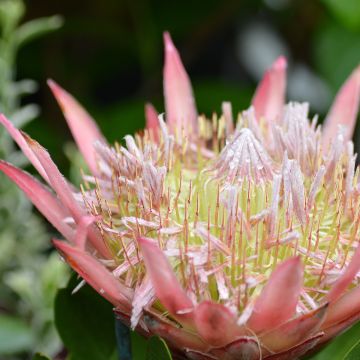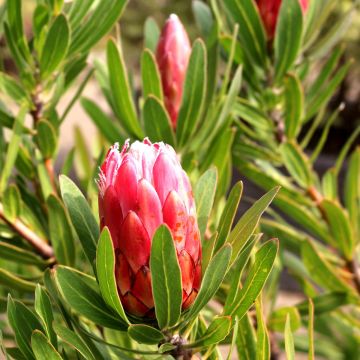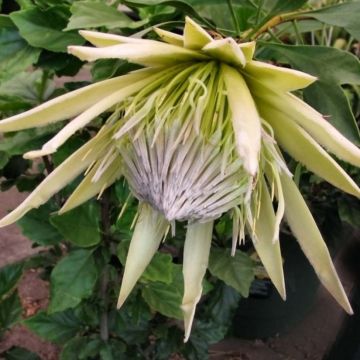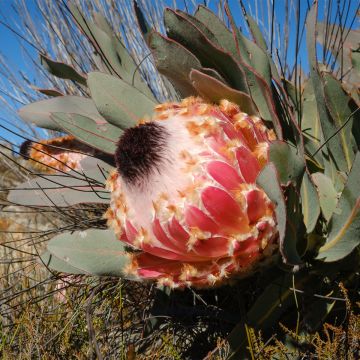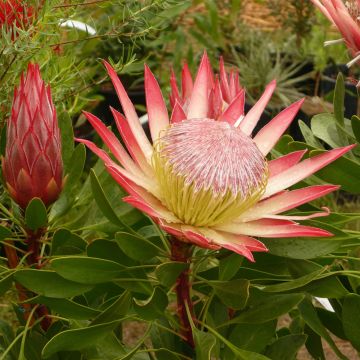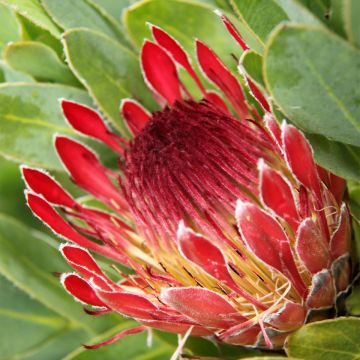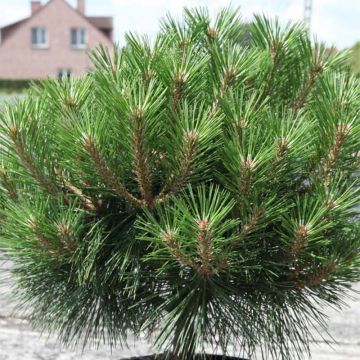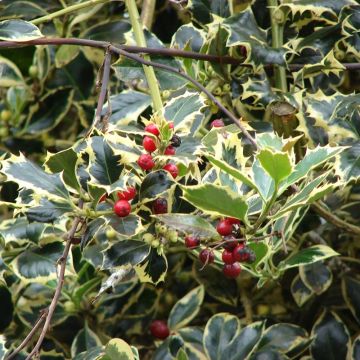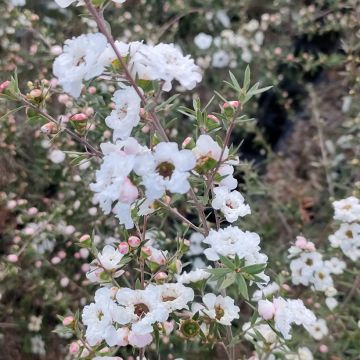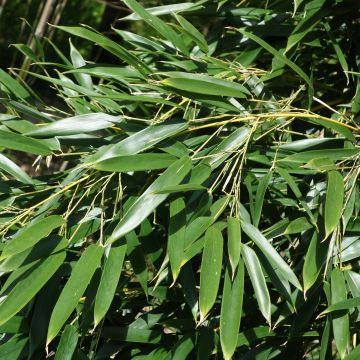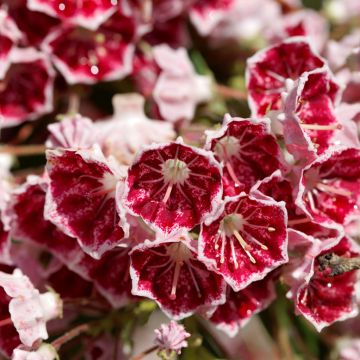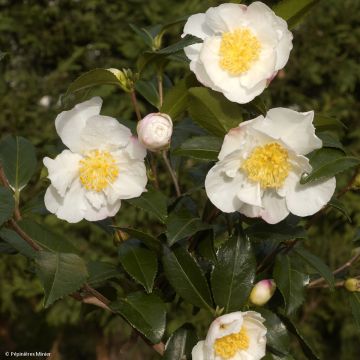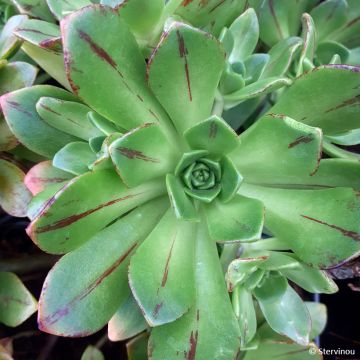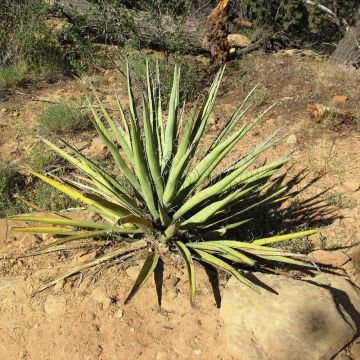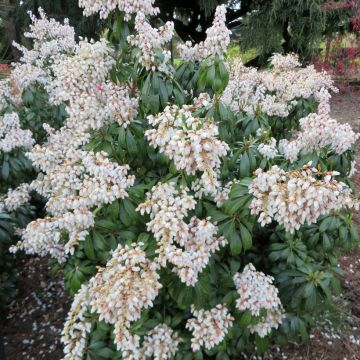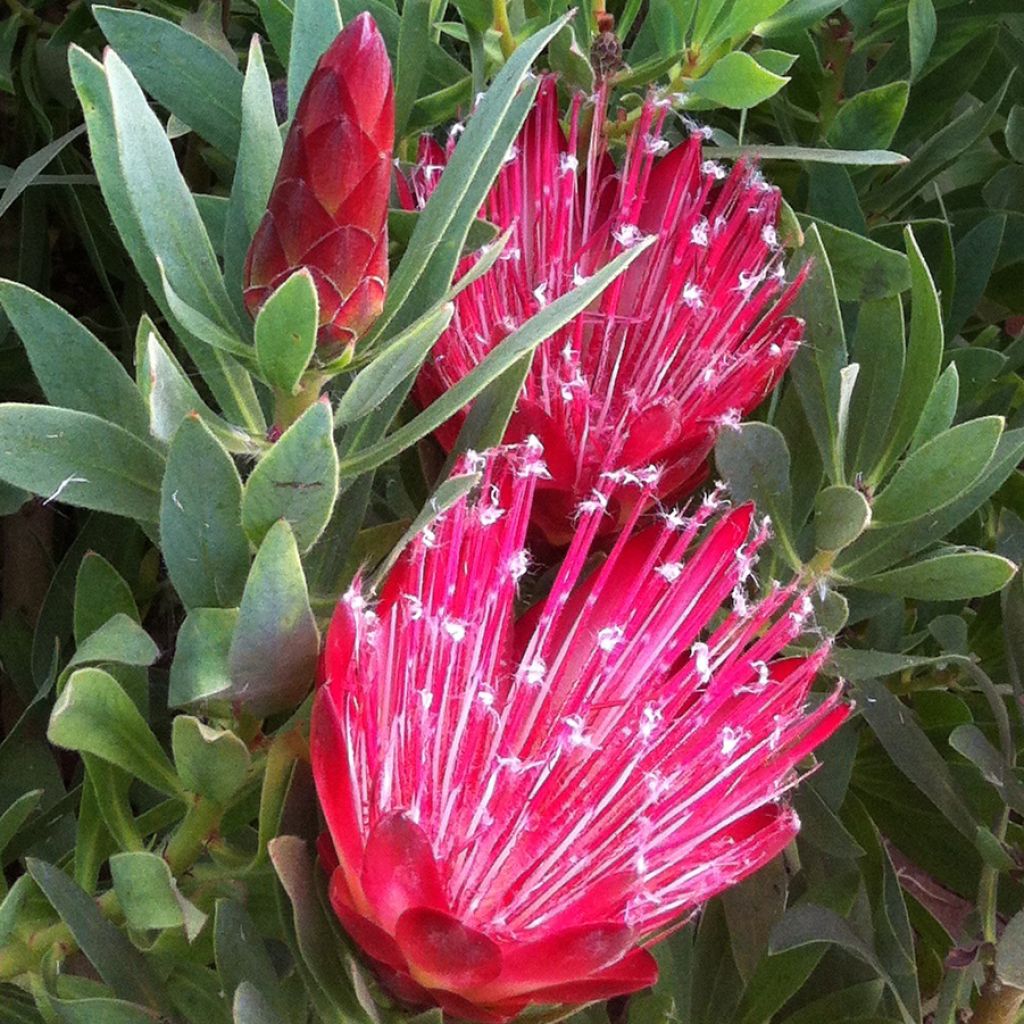

Protea Clark's Red - Protée hybride
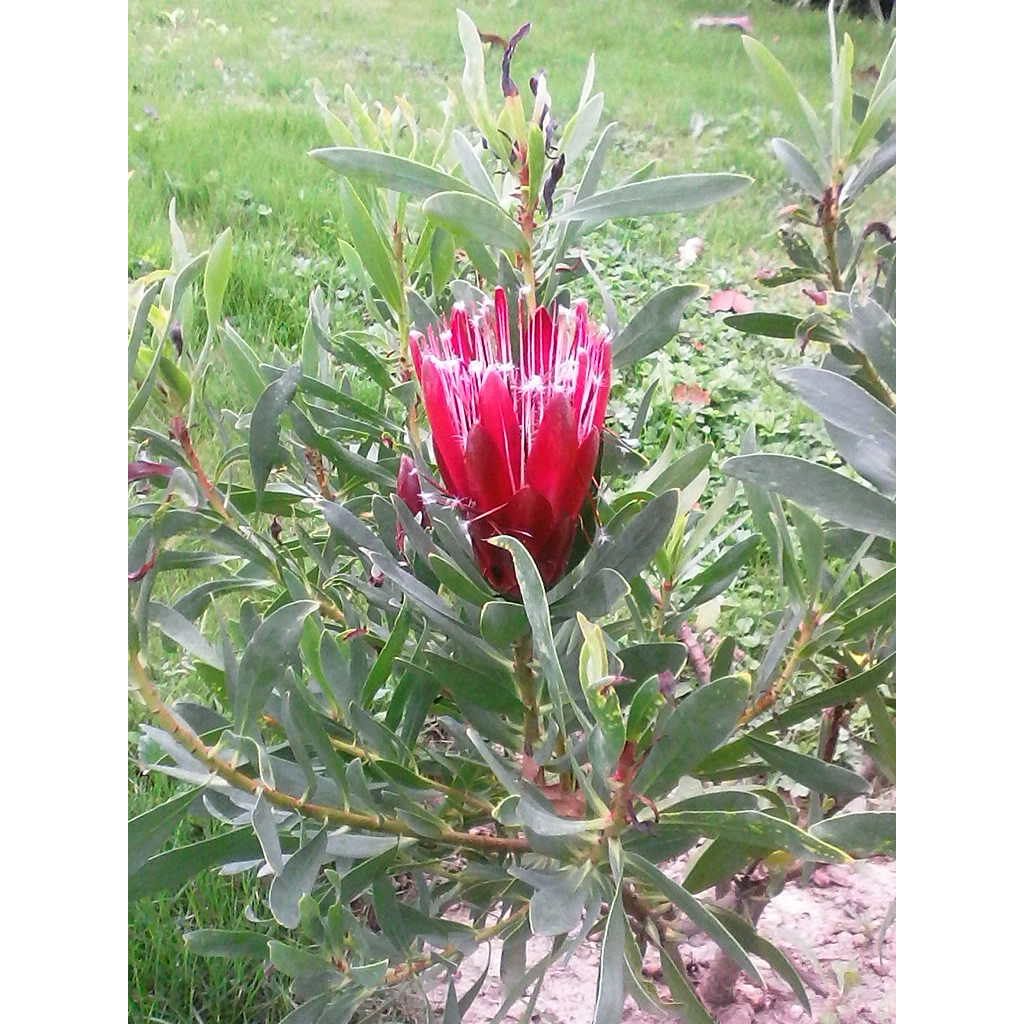

Protea Clarks Red
Protea Clarks Red
Protea Clark's Red
Hybrid Protea, Protea
This item cannot be shipped to the selected country
Delivery charge from €5.90
More information
Schedule delivery date,
and select date in basket
This plant carries a 24 months recovery warranty
More information
We guarantee the quality of our plants for a full growing cycle, and will replace at our expense any plant that fails to recover under normal climatic and planting conditions.
From €5.90 for pickup delivery and €6.90 for home delivery
Express home delivery from €8.90.
Does this plant fit my garden?
Set up your Plantfit profile →
Description
Protea 'Clark's Red' is an exotic shrub that is not very hardy, but truly fascinating. It will delight amateur gardeners who enjoy challenges. It flowers all year round in favourable conditions, the floral heads resembling large flared cups, formed of almost red, velvety, rose-coloured bracts, from which powdery white stamens emerge. Flowers are extremely long-lasting in dried bouquets. Cultivating it in large pots is preferable, outside the mildest areas, as it will be imperative to shelter the plant when the first frosts occur.
The 'Clark's Red' protea is the result of cross-breeding between Protea repens, undoubtedly the easiest species to cultivate, and Protea aurea, in its form with red flowers. Both are perennial shrubby plants of the protea family, native to the Cape region in South Africa. They are strange plants in every way, and require fire for their seeds to germinate.
'Clark's Red' develops multiple thick, ramified stems from a single trunk, giving it a dense and rounded habit. It will reach a height of between 2 m (7ft) and 2.50 m, with a width that is roughly equivalent. The size will remain more modest if the subject is kept in a pot for indoor cultivation. It has alternate, elongated, leathery leaves that remotely resemble those of oleanders, but with a green-blue shade. They have the ability to absorb atmospheric humidity. The flowering theoretically takes place throughout the year, but mostly between March and August. The inflorescences are compound heads made of leathery, pink to red bracts, resembling badminton ruffles, and are carried at the terminal part of each branch. They measure 8 to 10 cm (3 to 4in) in diameter. The floral buds are elongated and pointed. The head opens up, the bracts open to reveal a red and velvety heart, with white, feathery stamens. The flowering attracts numerous pollinating insects and gives way to a few velvety seeds. The thick roots of this plant also serve as a storage organ. In their natural environment, in the event of a fire, proteas are capable of regenerating from their roots, fertilised by their own ashes.
The 'Clark's Red' protea is a sensational plant that leaves no one indifferent. It will preferably settle in coastal gardens spared by heavy frosts, in light soil that is not too chalky. Particularly suited to the Mediterranean climate, it can tolerate poor, dry to arid soils and will look good when grown as an isolated specimen on large slopes or in the background of dry garden beds, but always in an open position, in full sun. In an exotic garden, it can be associated with Tree Echiums, King protea, Euphorbia characias, Euphorbia mellifera, Giant scabious, Melianthus major, palm trees or hybrid mulleins.
Report an error about the product description
Protea Clarks Red in pictures
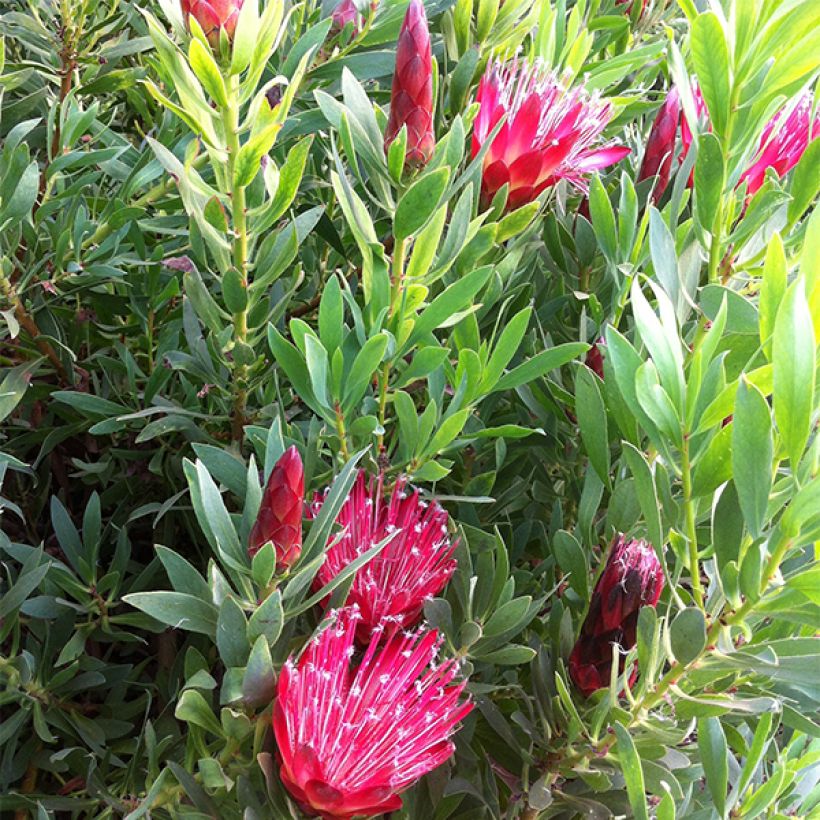

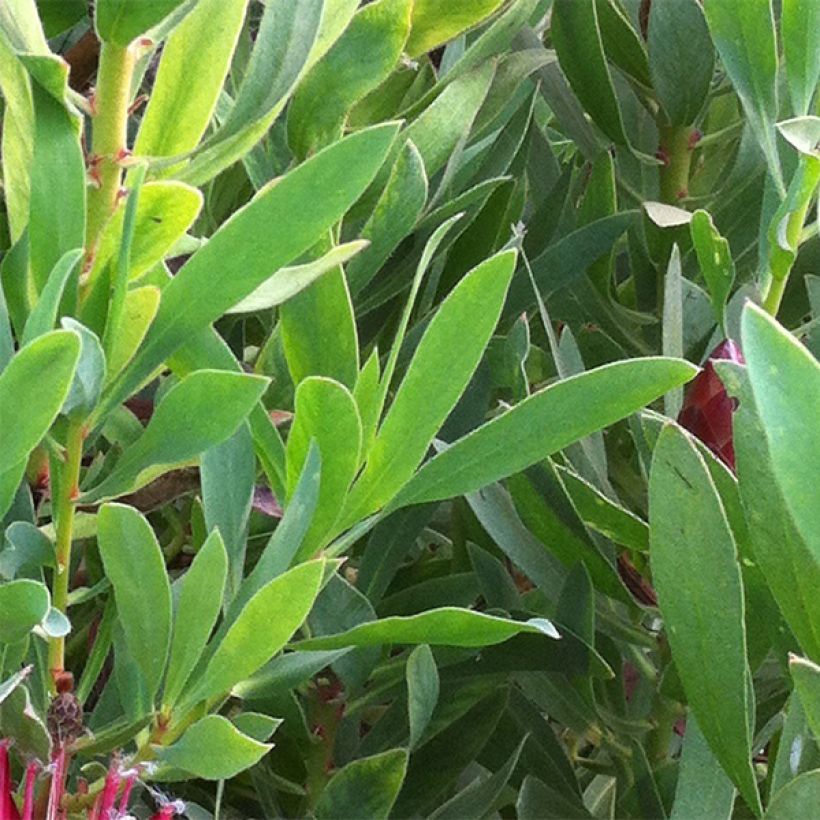

Plant habit
Flowering
Foliage
Botanical data
Protea
Clark's Red
Proteaceae
Hybrid Protea, Protea
Cultivar or hybrid
Other Protea
Planting and care
Plant 'Clark's Red' protea preferably in spring, or in autumn in mild climates, in a very sunny and sheltered position. This plant requires a light, well-drained soil, with a tendency towards acidity. A mixture including leaf compost, a little bit of ericaceous compost or crushed pine bark, and coarse river sand or perlite is usually appropriate. Proteas are sensitive to excess phosphates and nitrates, so it is important to avoid over-fertilising. While mature plants can tolerate occasional frosts of around -6 °C (21.2°F) in dry soil, young proteas should be protected from frost during their first few years, either in a frost-free area in cool climates or under a protective fleece in regions with mild winters. This plant blooms approximately 4 to 5 years after sowing. For indoor cultivation, it is important to ensure good ventilation in the room and avoid watering with hard water.
Planting period
Intended location
Care
-
, onOrder confirmed
Reply from on Promesse de fleurs
Evergreen shrubs
Haven't found what you were looking for?
Hardiness is the lowest winter temperature a plant can endure without suffering serious damage or even dying. However, hardiness is affected by location (a sheltered area, such as a patio), protection (winter cover) and soil type (hardiness is improved by well-drained soil).

Photo Sharing Terms & Conditions
In order to encourage gardeners to interact and share their experiences, Promesse de fleurs offers various media enabling content to be uploaded onto its Site - in particular via the ‘Photo sharing’ module.
The User agrees to refrain from:
- Posting any content that is illegal, prejudicial, insulting, racist, inciteful to hatred, revisionist, contrary to public decency, that infringes on privacy or on the privacy rights of third parties, in particular the publicity rights of persons and goods, intellectual property rights, or the right to privacy.
- Submitting content on behalf of a third party;
- Impersonate the identity of a third party and/or publish any personal information about a third party;
In general, the User undertakes to refrain from any unethical behaviour.
All Content (in particular text, comments, files, images, photos, videos, creative works, etc.), which may be subject to property or intellectual property rights, image or other private rights, shall remain the property of the User, subject to the limited rights granted by the terms of the licence granted by Promesse de fleurs as stated below. Users are at liberty to publish or not to publish such Content on the Site, notably via the ‘Photo Sharing’ facility, and accept that this Content shall be made public and freely accessible, notably on the Internet.
Users further acknowledge, undertake to have ,and guarantee that they hold all necessary rights and permissions to publish such material on the Site, in particular with regard to the legislation in force pertaining to any privacy, property, intellectual property, image, or contractual rights, or rights of any other nature. By publishing such Content on the Site, Users acknowledge accepting full liability as publishers of the Content within the meaning of the law, and grant Promesse de fleurs, free of charge, an inclusive, worldwide licence for the said Content for the entire duration of its publication, including all reproduction, representation, up/downloading, displaying, performing, transmission, and storage rights.
Users also grant permission for their name to be linked to the Content and accept that this link may not always be made available.
By engaging in posting material, Users consent to their Content becoming automatically accessible on the Internet, in particular on other sites and/or blogs and/or web pages of the Promesse de fleurs site, including in particular social pages and the Promesse de fleurs catalogue.
Users may secure the removal of entrusted content free of charge by issuing a simple request via our contact form.
The flowering period indicated on our website applies to countries and regions located in USDA zone 8 (France, the United Kingdom, Ireland, the Netherlands, etc.)
It will vary according to where you live:
- In zones 9 to 10 (Italy, Spain, Greece, etc.), flowering will occur about 2 to 4 weeks earlier.
- In zones 6 to 7 (Germany, Poland, Slovenia, and lower mountainous regions), flowering will be delayed by 2 to 3 weeks.
- In zone 5 (Central Europe, Scandinavia), blooming will be delayed by 3 to 5 weeks.
In temperate climates, pruning of spring-flowering shrubs (forsythia, spireas, etc.) should be done just after flowering.
Pruning of summer-flowering shrubs (Indian Lilac, Perovskia, etc.) can be done in winter or spring.
In cold regions as well as with frost-sensitive plants, avoid pruning too early when severe frosts may still occur.
The planting period indicated on our website applies to countries and regions located in USDA zone 8 (France, United Kingdom, Ireland, Netherlands).
It will vary according to where you live:
- In Mediterranean zones (Marseille, Madrid, Milan, etc.), autumn and winter are the best planting periods.
- In continental zones (Strasbourg, Munich, Vienna, etc.), delay planting by 2 to 3 weeks in spring and bring it forward by 2 to 4 weeks in autumn.
- In mountainous regions (the Alps, Pyrenees, Carpathians, etc.), it is best to plant in late spring (May-June) or late summer (August-September).
The harvesting period indicated on our website applies to countries and regions in USDA zone 8 (France, England, Ireland, the Netherlands).
In colder areas (Scandinavia, Poland, Austria...) fruit and vegetable harvests are likely to be delayed by 3-4 weeks.
In warmer areas (Italy, Spain, Greece, etc.), harvesting will probably take place earlier, depending on weather conditions.
The sowing periods indicated on our website apply to countries and regions within USDA Zone 8 (France, UK, Ireland, Netherlands).
In colder areas (Scandinavia, Poland, Austria...), delay any outdoor sowing by 3-4 weeks, or sow under glass.
In warmer climes (Italy, Spain, Greece, etc.), bring outdoor sowing forward by a few weeks.

































